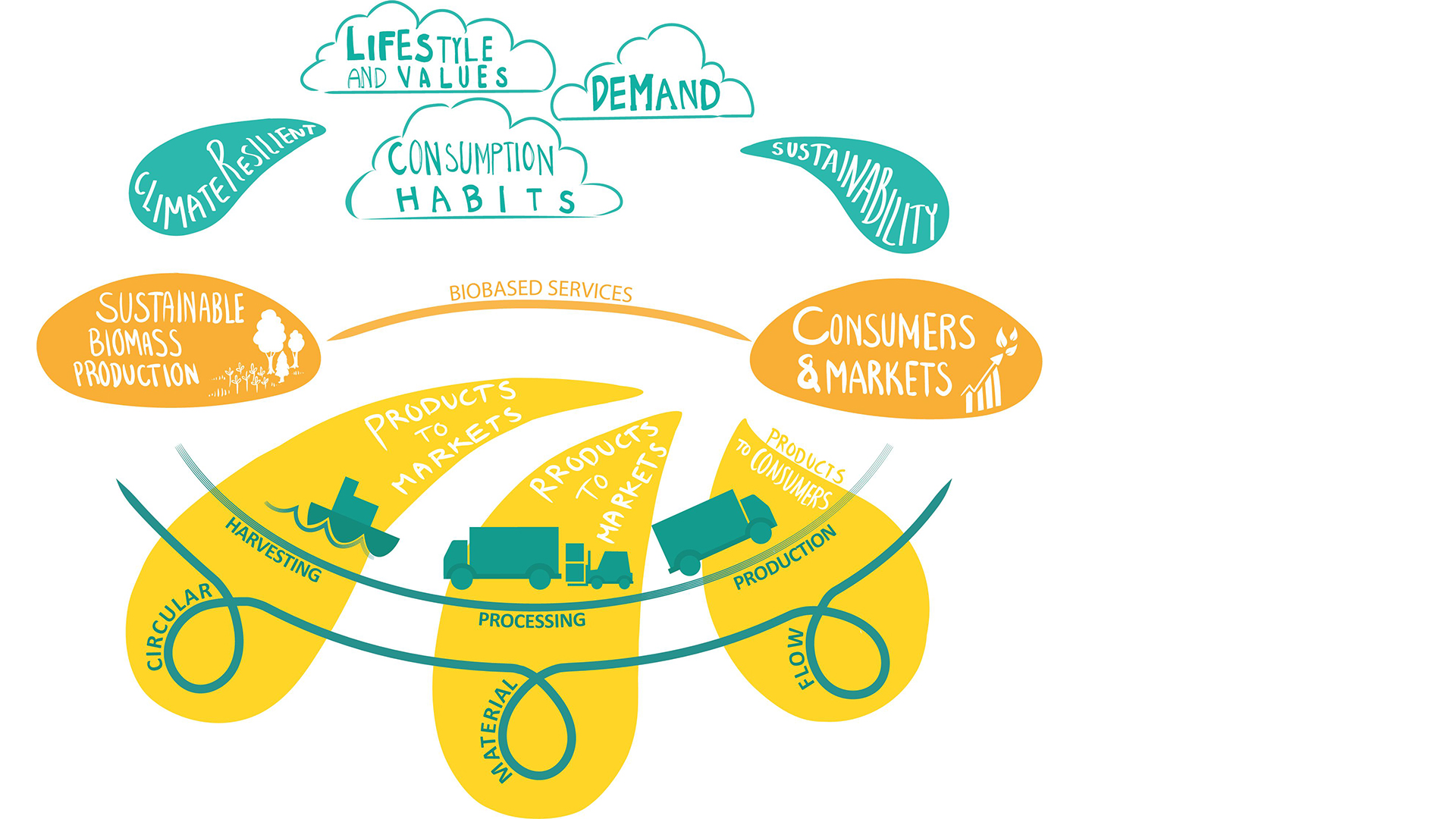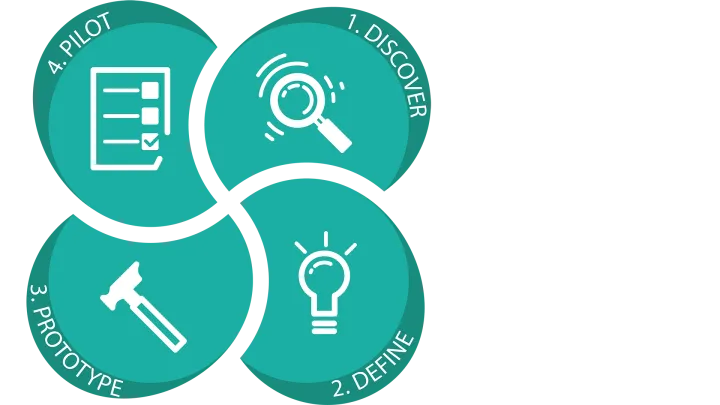RDI2CluB and Biobord Results
From this section you will find all main outputs and results of the projects.
1. Regional Bioeconomy Profiles
Regional Bioeconomy Profile offers a tool for studying the bioeconomy performance of a region to assist regional decision makers in smart specialisation work. It is a collection of bioeconomy related statistical data (production, employment, turnover, etc.) of a regional area. It enables a comprehensive picture of partner region’s bioeconomy performance and gives ideas on the possible development areas within bioeconomy. Bioeconomy profile default setting is the comparison of a region to national average. In addition, bioeconomy profile tool also enables comparison between the regions.
With the help of Regional Bioeconomy Profiles, the regional authorities and development bodies will get a better understanding of the possibilities of the regional bioeconomy to support their decision-making and smart specialization approach. Based on the data collection done in RDI2CluB, the online tool provides a basic profile for any region in Finland, Estonia, Latvia, Norway, and Poland.
Output
Access to the Regional Bioeconomy Profiles and the web-tool ›
Report on the development process of the Regional Bioeconomy Profiles ›
2. Joint Action Plan
After Regional Bioeconomy Profiles, next step in the RDI2CluB –project was to identify actions to boost smart and sustainable rural bioeconomy in each region as well as co-operation areas between the involved regions.

What is Joint Action Plan ?
Joint Action Plan (JAP) is aiming to support smart, sustainable, and inclusive growth of bioeconomy in the rural regions. It has been developed in cooperation with authorities working with aim to implement national Smart Specialization Strategy, universities, RDI institutes, business development bodies, clusters, bio-economy businesses, and other stakeholders.
JAP is elaborated as a roadmap and is connected to the EU and EUSBSR strategies, aiming to promote regional development, innovation and bioeconomy.
The JAP is including measures and actions, structured in two groups:
- Internal (regional and/or national) measures and actions (to be implemented by one or several actors at regional level)
- Transnational measures and actions (to be implemented by involving partners from two or more different regions).
The themes of transnational innovation pilots of the extension stage project ConnectedByBiobord derive from the JAP.
The regions are continuing the co-working on the Joint Action Plans in the Biobord Network.
Output
Joint Action Plans of the RDI2CluB project partnership (Full report) ›
Joint Action Plans of the RDI2CluB project partnership (Short edition) ›
Regional Action Plan, Central Finland ›
Regional Action Plan, Świętokrzyskie Voivodeship, Poland ›
Regional Action Plan, Vidzeme Planning Region, Latvia ›
Regional Action Plan, Estonia ›
Regional Action Plan, Inland Region Norway (transl. with RDI2CluB support) ›
3. Biobord Platform & Operating Model
Biobord-platform is an open digital platform that connects bioeconomy developers around Baltic Sea region to solve local and global challenges though bioeconomy innovations. Platform is free for all and connects different actors from different sectors and countries, with just one thing in common – bioeconomy.
The Biobord Operating Model describes the potential of our network, the functionalities of the platform as well as the user profiles and service paths. Furthermore, the Operating Model provides practical guidance and tools for the uptake of the Biobord, creation of the service paths as well as continuous improvement of the forum community building. It also contains the Biobord user policies and user guides.
Biobord Operating Model 3.0 was published in the RDI2CluB in September 2020 and can be found from here (pdf).
However, in the extension stage project ConnectedByBiobord, the Biobord Operating Model was replaced with more practical Biobord guides and operating practices to make the operations more sustainable and practical. In the extension stage project ConnectedByBiobord, the Biobord Operating Model was replaced with more practical Biobord guides and operating practices to make the operations more sustainable and practical. You may always find the most updated versions of the guides and operational documents from biobord.eu/about.
Iterative development process of Biobord and Operating Model
Biobord and Operating Model have been developed in an iterative service design process with two piloting phases. First piloting period was in September – December 2019 for developing Biobord Operating Model version 1.0 and testing the prototype of Biobord-platform. Piloting period collected feedback from the end-users (bioeconomy innovation actors) and Operating Model 1.0 and Biobord-platform were improved by that.
Main conclusions of the development process:
- Biobord design process was based on four key stages: Discover, Define, Prototype, Pilot. Biobord piloting with the collecting of the feedback directly from the users was the best possible approach for successful development of Biobord Operating Model and Biobord platform.
- Agile approach in piloting and testing with a growing spectrum of users/testers in each iteration, assures complex data collection. It is good to focus on a different aspect of the platform development during each of iterations to help the users in reflecting the right things.
- Well-designed piloting and testing criteria with numerous technics and sources of data collection, provides very useful information, necessary for Biobord Development.
- Transnational cooperation and cross-cluster learning, dissemination of developed solutions, feedback collection and analysis of the results within RDI2CluB team assure steady and permanent progress on the Operating Model and Biobord platform.
- Development of a platform is a long-term process; it takes time to collect needed feedback and analyze the results. Small steps are better in the development process, than few big steps.
- Technical development of the platform should be based on the simple and clear solutions. Providing options and examples of the development targets gives better results in feedback collection of the testers.
Read the whole report of the first piloting period:

The second piloting was conducted in January- April 2020 and it aimed to improve the user-experience of Biobord-platform and content for Operating Model 3.0. Improved Biobord was launched in May 2020 and Operating Model 3.0 in September 2020.
Upgrades made Biobord-platform easier to understand for external users and made information seeking simpler with the new tag-system. The aim of the updates is to attract more external users to Biobord.
Read the whole report of the second piloting period:
Biobord Network Model Upgraded with Value Proposition & Updated Platform Operating Practices
In ConnectedByBiobord project, the Biobord Operating Model has been upgraded completely (including all connected documents) to reflect the lessons learned from innovation piloting and from the extension of the network. The structure was re-formatted to enhance user-friendliness, and to make the content easy to update. Also, new documents, the Biobord Network Agenda, and the Innovation process guide have been introduced.
All guides and documents can be found from https://biobord.eu/about/
As one of the main guiding principles for developing the network operating model, a mantra of ‘keep it simple!’ was maintained. This was applied with the upgraded platform navigation features, structured network management documentation, and with the guide designs and tutorial videos.
As a result, we now have a section ‘What can we do for you?’ at the About -page that features relevant and targeted information for:
- Prospective user of the Biobord platform
- Registered user of the Biobord platform
- Biobord Network Partner
- Aspiring Biobord Network Partner
In total of five Biobord User Guides (1-5) and three Biobord Network Partner Guides (1-3) were created, as practical manuals guiding activities in the network and at the platform. User guides are accompanied by video tutorials that feature different platform functions in 3-10 minutes. Tutorirals are coming soon!
The platform management and network administration have been streamlined with clearer roles for the partners and the Network Secretary. As the Network Secretary, JAMK University of Applied Sciences has taken some of the administrative burden and quality assurance tasks under their administration. These include e.g. the organization of the data protection, handling of partner applications, and the content creation in the Biobord platform.
As an extra benefit of the design of the innovation process, we also opted to utilize the Joint Agenda Canvas to develop the Biobord Network Agenda. This approach gave as an opportunity to elaborate, prioritize, and summarize the essential information and the concept of the Biobord network into two pages. Coming from the well-over hundred-page operating model to a two-page agenda is not only a victory for our future communication efforts, but it is also a showcase of improved understanding of the core purpose and value of the network co-operation.
We now have a clear value proposition for current and future partners supported by an upgraded network agreement that will be signed by the partners in Autumn 2021. All ready to future co-operation!
Biobord network
Perhaps the most important outcome from both project was the launch of the sustainable bioeconomy network called Biobord network. The aim of the network is to safeguard the main results of the projects, as well as maintain transnational co-operation. Read more of the practices of the Biobord network from here.
4. Publications
25 Cases for Bioeconomy Innovation
RDI2CluB-project has prepared a publication with the support of Nordic Council of Ministers to showcase inspirational stories of bioeconomy innovations in five RDI2CluB partner regions. 25 cases have been structured in four sub-groups:
- Sustain: biodiversity and ecosystem services
- Increase: business and competitiveness
- Unlock: potential
- Collaborate: for positive change
With five criteria and related assessment parameters, readers may evaluate bio-cases. Criteria includes sustainable use of resources, social benefits, environmental benefits, business model innovation and technological innovation.